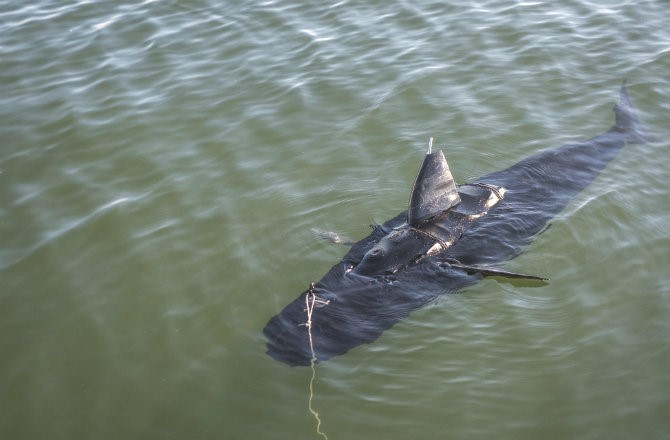
If you spot a dorsal fin sticking out of the water and swimming directly at you, odds are that it’s not the US Navy’s GhostSwimmer underwater drone, but rather, an actual shark. Under the guidance of Boston Engineering, not to be confused with Boston Dynamics, the other Boston-based robotics design firm, the Navy is developing a nature-inspired unmanned underwater vehicle (UUV) for use in reconnaissance missions. And by “nature-inspired,” we mean that it looks like a shark and fools nautical vessels into complacency; unfortunately, head-mounted laser cannons are not included.
The GhostSwimmer adheres to the school of biomimetic design principles, meaning, its creators incorporated millions of years of biological evolution to create a streamlined machine that emulates animal processes in nature. These principles are exemplified in the way the robot swims, by oscillating its tail fin back and forth to create a fish-like form of propulsion that’s reportedly quieter than a propeller-drive craft of approximately the same size. Michael Rufo, director of Boston Engineering’s Advanced Systems Group, explains on the GhostSwimmer’s project page that the robot is also “a combination of unmanned systems engineering and unique propulsion and control capabilities.” Together, these features lend themselves well for clandestine operations such as surveillance and reconnaissance.
The Navy is not disclosing how the GhostSwimmer transmits and receives data, but the press release states that the robot has to periodically surface to upload the information it gathered. What we do know more specifically is that the GhostSwimmer measures five feet (1.5 m) in length, weighs almost 100 lb (45kb), and is described as mimicking the body shape of a large fish, presumably a shark. The robot can also dive up to a maximum of 300 feet (91 m).
GhostSwimmer is controlled by a 500-feet (152 m) long cable tethered to a computer onboard a ship, enabling it to relay video feed and other data in real time. Alternatively, the robot can be programmed to operate autonomously thanks to a series of onboard sensors and a long battery life.
A recent test conducted at the US Navy’s Joint Expeditionary Base East, in Virginia Beach, Virginia, demonstrated how the GhostSwimmer can be used for “civilian” activities too, when it gathered data on tides, varied currents, wakes, and weather conditions. Another major bonus: Boston Engineering hopes GhostSwimmer will replace the bottlenose dolphins and sea lions that the Navy currently uses to sniff out underwater mines.
Source: Gizmag via Boston Engineering
Advertisement
Learn more about Electronic Products Magazine





